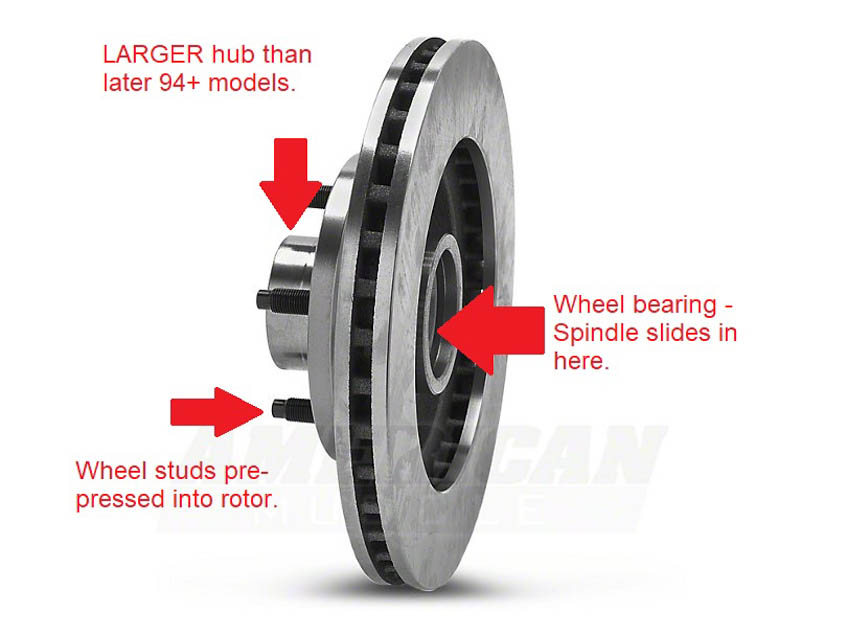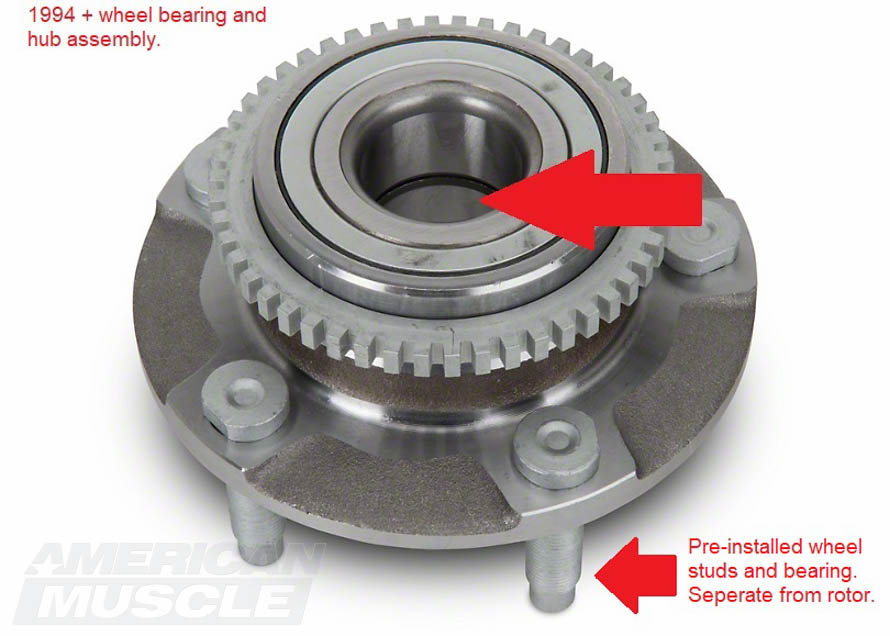Please note, it is not necessary to convert your Fox to 5-lug in order to perform a rear disc brake conversion. You can keep the car 4-lug (as it is from the factory) and still have disc brakes. This next section denotes this (staying 4-lug, but converting the rear drum brakes to disc). However, as mentioned, many owners swap to 5-lug at the same time as it gives them a larger choice of wheels.
4-lug: converting the rear disc brakes
Converting the OE 4-lug rear drum into a 4-lug disc brake setup using the stock Mustang axles necessitates the use of rear calipers from any of the following cars:
- 1987-88 Ford Thunderbird
- 1993 Mustang Cobra
- 1987-88 Mercury Cougar
- 1989-92 Ford Taurus
- 1988-92 Lincoln Continental, 1991-92 Lincoln Mark VII
- 1990-92 Mercury Sable
Be sure to grab all accompanying hardware with the calipers as well (bolts, brackets). Factory 4-lug rotors can be sourced from 1993 Cobras or 1987-88 Thunderbirds. Now that all brakes are a disc, you will need a larger master cylinder as well. A 1-1/8" bore master cylinder from 1984-86 Mustang, 1974-89 Lincoln Continental or 1984-89 Lincoln Mark VII will work.
Regarding caliper brackets, I do not believe any of the stock Ford sourced brackets will fit. Perhaps with some modification they can be made to work, but I am unsure. Alternatively, there is a ready-made version, by North Race Cars, that you can purchase and will bolt right up, no modification to any component necessary. (I think they are $150 for a set).
5-lug: converting the rear to disc
If you want to go with a 5-lug disc brake setup, of course you first have to convert to 5-lug! After that, you can source nearly all of the parts from any 1994-98 Mustang (be it a GT, V6 or Cobra... any will do).
What you need from any 1994-98 Mustang: left & right calipers, caliper brackets and 10.5" solid rear rotors (5-lug, booyah baby!). I have heard that the stock SN95 (94-98) caliper brackets will work, with a little modification, simply by swapping right to left and left to right. The previously mentioned 'little modification' comes in the form of grinding down the inside of the bracket so that it doesn't grate against the bracket mount. Again, North Race Cars also sells a pre-made, direct fit bracket kit if you prefer a guaranteed fit. Alternatively, just grab the entire rear-end (8.8") and drop it in.
Aftermarket Kits
Up until now we focused solely on a budget build, sourcing nearly all parts from other vehicles. The aftermarket does provide pre-packaged kits for both 5-lug conversion and disc brake conversion. If you would prefer to go this route, check online with your favorite vendors. Most offer their own conversion package featuring new parts. For example, Alloy USA has a complete 4-lug to 5-lug conversion kit with all new parts for $400. If you don't feel like scrounging around your local scrap yard, it's a great option.
If you want to go seriously aftermarket (and spend a pretty penny or two), check the offerings from known brake vendors such as Wilwood and Brembo. Wilwood has a lot of really nice options for Mustangs of all years. They offer full conversion kits (drum to disc with everything included), big brake upgrades etc. They have nice stuff, and it is reasonably priced in my opinion.
Some other useful information for BOTH 4-lug and 5-lug disc conversions
Some other parts you will need; adjustable proportioning valve and solid end cap, a new master cylinder (2 port, bore size dependent on caliper size) and some adapters to connect the caliper soft brake lines to the rigid lines. Generally speaking, a 1-1/8" master cylinder from a 93 Cobra or SN95 Mustang will be more than fine for the job.
Soft lines can be sourced from 1994-98 Mustangs, or be a handy-man and come up with your own adaptive solution. A note about the master cylinder, it is possible to convert a 3-port MC to a 2-port, so there is always that option too. As far as I know, it isn't too difficult, you just need some special adapters.
Furthermore, you may need to swap the stock brake booster out for another one if you change master cylinders. A booster from any SN95 V6 will work great.
The dreaded parking brake (FIX)
Perhaps the biggest area of confusion regarding a disc brake swap (regardless of 4 or 5-lug) is how to get the parking brake to work. For this, you will need new e-brake cables. Specifically: (2) FMS M-2809-A cables, (1) FMS M-2810-A center e-brake cable. There is also a special modification that must be done at the parking brake handle for it to work correctly. In a nutshell, it requires eliminating the self-adjusting mechanism on the handle by cutting the tensioning spring and permanently attaching (via welding) the pawl onto the ratchet gear.




